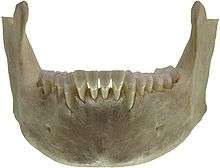Chin
| Chin | |
|---|---|
.png) Chin or mental region labeled in purple | |
| Details | |
| Artery | Inferior alveolar artery |
| Nerve | Mental nerve |
| Identifiers | |
| Latin | Mentum |
| MeSH | A01.456.505.259 |
| TA | A01.1.00.011 |
| FMA | 46495 |
The chin or the mental region is the area of the face below the lower lip and including the mandibular prominence.[1][2] It is formed by the lower front of the mandible. In humans there is a wide variety of chin structures, e.g. cleft chin.
In human evolution, the chin is a cladistic apomorphy, partially defining anatomically modern humans as distinct from archaic forms. Non-human anthropoid apes have a simian shelf for example. Elephants are the only other animals considered to display such a feature,[3] although this leads to debate over the use of the term.[4]
The chin emerged during the Middle and Late Pleistocene, but its origin and biomechanical significance are the subjects of controversy.[5] Prominent hypotheses include buttressing the jaw against stresses resulting from speech[5] or chewing[6] as well as simple sexual selection through mate choice.[7] With the advent of more advanced computational facilities, finite element analyses have been used to support hypotheses involving mechanical stress.[8] On the other hand, increased availability of data regarding sexual dimorphism in chins has also lent support to the sexual selection hypothesis as sexual dimorphism is more difficult to explain under other regimes.[7] It is possible that multiple causal factors have played a role in the chin's evolution.[9]
Variations
Double chin

A double chin is a layer of subcutaneous fat around the neck that sags down and creates a wrinkle, making the owner appear to have a second chin. This fat pad is sometimes surgically removed and the muscles under the jaw shortened to remove the double chin.[10]
Cleft chin


The terms cleft chin,[11] chin cleft,[11][12] dimple chin,[13][14] or chin dimple,[11] refer to a dimple on the chin. It is a Y-shaped fissure on the chin with an underlying bony peculiarity.[15] Specifically, the chin fissure follows the fissure in the lower jaw bone that resulted from the incomplete fusion of the left and right halves of the jaw bone, or muscle, during the embryonal and fetal development. For other individuals, it can develop over time, often because one half of the jaw is longer than the other, leading to facial asymmetry.[11]
This is an inherited trait in humans, where the dominant gene causes the cleft chin, while the recessive genotype presents without a cleft. However, it is also a classic example for variable penetrance[16] with environmental factors or a modifier gene possibly affecting the phenotypical expression of the actual genotype. Cleft chins are common among people originating from Europe and the Middle East.[17]
In Persian literature, the chin dimple is considered a factor of beauty, and is metaphorically referred to as "the chin pit" or "the chin well": a well in which the poor lover is fallen and trapped.[18]
See also
- Chin augmentation (genioplasty)
- Mandible
- Masseter
- Mastication
- Otofacial syndrome
References
- ↑ "Full Definition of chin". Merriam-Webster Dictionary. Retrieved 2015-09-22.
- ↑ O'Loughlin, Michael McKinley, Valerie Dean (2006). Human anatomy. Boston: McGraw-Hill Higher Education. pp. 400–401. ISBN 0-07-249585-5.
- ↑ Enlow, Donald H. (1982). Handbook of facial growth. Philadelphia: Saunders. p. 283. ISBN 0-7216-3386-2.
In the human mandible, a prominent chin marks this region, a distinctive feature that characterizes the face of modern man (and also, for reasons yet to be studied, the elephant).
- ↑ Schwartz, Jeffrey H. (2000). "The human chin revisited: what is it and who has it?". Journal of Human Evolution. 38 (3): 402. doi:10.1006/jhev.1999.0339. PMID 10683306.
When humans and elephants can both be described as having chins, it is probably time to reconsider the applicability of the term.
- 1 2 Ichim, Ionut; Jules Kieser; Michael Swain (2007). "Tongue contractions during speech may have led to the development of the bony geometry of the chin following the evolution of human language: A mechanobiological hypothesis for the development of the human chin". Medical Hypotheses. 69 (1): 20–24. doi:10.1016/j.mehy.2006.11.048.
- ↑ Daegling, David J. (1993). "Functional morphology of the human chin". Evolutionary Anthropology: Issues, News, and Reviews. 1 (5): 170–177. doi:10.1002/evan.1360010506.
- 1 2 Thayer, Zaneta M.; Seth D. Dobson (2010). "Sexual dimorphism in chin shape: Implications for adaptive hypotheses". American Journal of Physical Anthropology. 143 (3): 417–425. doi:10.1002/ajpa.21330.
- ↑ Gröning, Flora; Jia Liu; Michael J. Fagan; Paul O'Higgins (2011). "Why do humans have chins? Testing the mechanical significance of modern human symphyseal morphology with finite element analysis". American Journal of Physical Anthropology. 144 (4): 593–606. doi:10.1002/ajpa.21447.
- ↑ Wayman, Erin. "Why Do Humans Have Chins?". Smithsonian magazine — Hominid Hunting. Smithsonian Institution. Retrieved 2012-12-22.
- ↑ Larkin, Dimitrije E. Panfilov ; translated by Grahame (2005). Cosmetic surgery today. Stuttgart: Thieme Medical Publishers. p. 64. ISBN 1-58890-334-6.
- 1 2 3 4 Mammalian Phenotype Browser:Cleft chin
- ↑ Sharks of the world, Vol. 2, pg. 143; by Leonard J. V. Compagno, Food and Agriculture Organization of the United Nations, 2001.
- ↑ Rob Roy, pg. 229 (in 1872 edition, pub. Osgood); by Sir Walter Scott, 1817.
- ↑
- ↑ Online Mendelian Inheritance in Man (OMIM) 119000
- ↑ Starr, Barry. "Ask a Geneticist". Understanding Genetics. TheTech. Retrieved 2007-07-01.
- ↑ Günther, H. Anomalien und Anomaliekomplexe in der Gegend des ersten Schlundbogens. Zeitschrift für menschliche Vererbungs- und Konstitutionslehre 23: 43-52. Lebow, M.R., and P.B. Sawin. Inheritance of human facial features: a pedigree study involving length of face, prominent ears and chin cleft. Journal of Heredity 32: 127-132.
- ↑ چاه زنخدان the chin well
| Wikimedia Commons has media related to Chins. |